February itinerary in Japan Day 1 (Hyogo Meal edition)
(Wednesday, February 23)
Table of contents
1, “Botan-tei” Botan Nabe (Wild Boar Hotpot)
3, Sasayama Castletown Hotel NIPPONIA
1, “Botan-tei” Botan Nabe (Wild Boar Hotpot)
I had “Botan nabe (Wild Boar Hotpot)” at “Botan-Tei” as the first meal of this trip. To eat “Botan nabe” was the biggest reason to visit Tanba Sasayama this time. “Botan nabe” has been selected by the Ministry of Agriculture, Forestry and Fisheries as one of the “100 Best Local Cuisine” in Hyogo Prefecture.
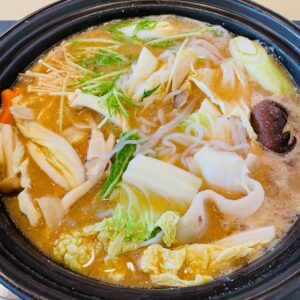
The wild boar hunting season is from November 15th to March 15th, so it is a winter game meat cuisine. “Botan-tei” is also open only in the fall and winter. Along with Mt. Amagi in Shizuoka Prefecture and Gujo Hachiman in Gifu Prefecture, the Tanba Sasayama region is also famous nationwide as the “three major hunting grounds in Japan” for wild boars.
It is said that “Botan nabe” started when wild boar meat, which was stationed in Sasayama-cho, Hyogo prefecture in the Meiji era, was put into miso soup by the former Japanese Army. In other words, the Tanba Sasayama region is the origin of “Botan nabe”. The wild boar of Tanba Sasayama eats nuts such as Tanba chestnuts, Tanba matsutake mushrooms, and grains, so it is not greasy and is very delicious.
By the way, Tanba chestnut is a delicious chestnut that is famous all over the country. The history of Tanba chestnut is very long, and it is said that Emperor Jito (reigned 690 to 697) encouraged cultivation. In addition, it has been known for a long time so that the name of Tanba chestnut appears in Kojiki, Manyoshu, and Nihon Shoki. It is also said to be the name of Japan’s oldest regional brand crop.
According to the official tourist website of Tanba Sasayama City, “Botan nabe” is derived from the fact that “boar” was replaced with “Botan (peony)” in the Edo period when the common people were prohibited from eating meat. Similarly, “horse” was called “Sakura” and “deer” was called “Momiji (maple)”.
I think that the theory that “Botan nabe” was called “Botan nabe” because the arrangement is similar to “Peony flower” is strongly supported as the origin of the name. However, according to the official tourism website of Tanba Sasayama City, a long-established inn in Tamba Sasayama City was inspired by the name “Botan nabe” and served wild boar meat to resemble “peony flowers” around 1945.
I ordered a “mixed hot pot” containing half of the special loin meat and half of the special rib meat at “Botan-tei”. During the hunting season, the wild boar meat of “Botan-tei” was chilled and chilled while keeping the freshness of the raw meat to bring out the flavor of the wild boar meat.
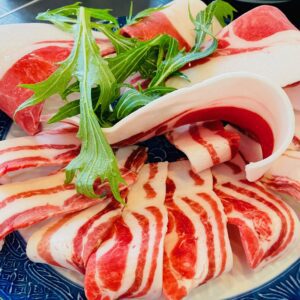
In a word, the taste of “Botan nabe” was “excellent”. “Botan nabe”, which uses miso mixed with chestnuts and contains a large amount of wild boar meat, vegetables, shiitake mushrooms, tofu, etc., exudes each other’s taste into the pot and becomes an exquisite taste. Tourists were sparse in sightseeing in Tanba Sasayama City, but “Botan-tei” was full. Many tourists visit Tanba Sasayama City from Osaka, Kyoto, Kobe just for the purpose of “Botan nabe” of “Botan-tei”.
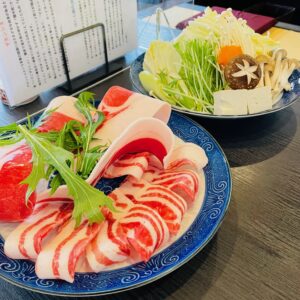
A wild boar object was installed on the building of “Botan-tei”. The taste and objects were wonderful.
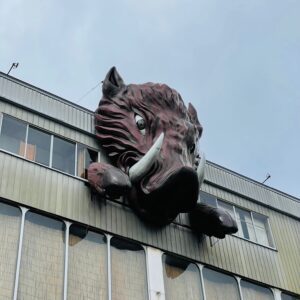
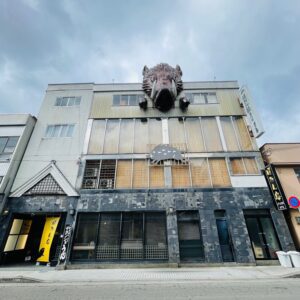
2, Houmei Sake Brewery
After visiting Kasuga Shrine, I was planning to go to Fukusumi (a national important traditional building preservation district). But I couldn’t go to Fukusumi because the bus I was planning to board arrived one minute before the scheduled time. Therefore, I decided to go to Houmei Sake Brewery, which was near the bus stop. This was a very lucky happening.
Houmei Sake Brewery is a long-established sake brewery founded in 1797. The building of the store was also very old and had a very nice atmosphere with high ceilings. Hina dolls were also displayed.


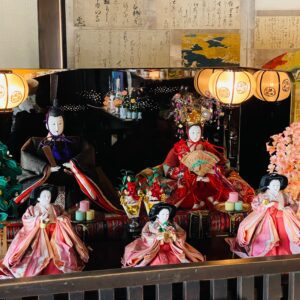
At Houmei Sake Brewery, I drank 5 kinds of drinks (Yen 660). Everything from Junmai Daiginjo Sake to Junmai Sake was very delicious. Moreover, all five types were large in quantity, and it was a nice sake set.
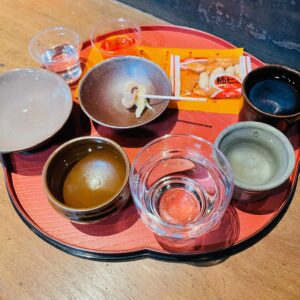
At Houmei Sake Brewery, I was able to tour the sake brewery. It was a wonderful sake brewery like a folk museum, and I felt like I had traveled back in time to the Edo period. On the other hand, Houmei Sake Brewery is a sake brewery that is actively working on new initiatives such as music vibration sake (Japanese sake grown by listening to Mozart and dekansho-bushi) and liqueur sake using black beans and chestnuts, which are the specialties of Tanba Sasayama city. I had a good impression. The clerks at Houmei Sake Brewery were also very kind and I enjoyed talking with them.
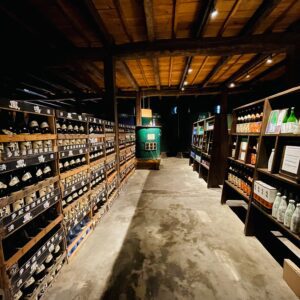
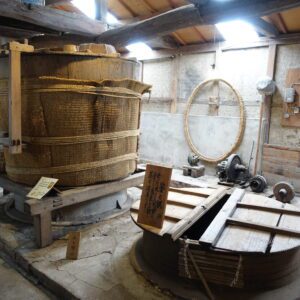
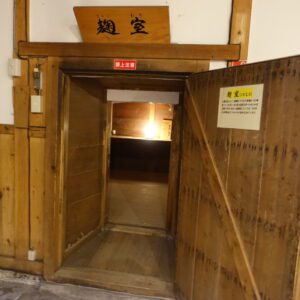
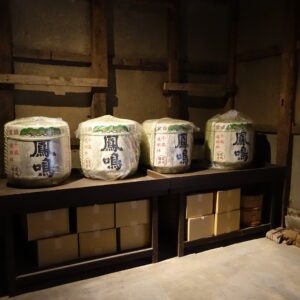
3, Sasayama Castletown Hotel NIPPONIA
I had dinner at our accommodation, Sasayama Castletown Hotel NIPPONIA. It was an old folk house hotel, so the entrance of the restaurant had a nice atmosphere.

First of all, I drank beer (happo-shu) using Tanba black soybeans. Tanba black soybean is a black soybean called “Tanba black” that originated in the Tanba region. This high-class black soybean is very famous nationwide. Black soybean beer was a delicious beer with a faint aroma and taste of black soybeans.
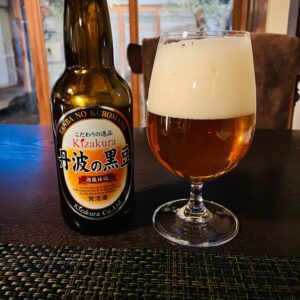
The dinner at Sasayama Castletown Hotel NIPPONIA was a French course. The first dish was “Seasonal Vegetable Gargouille”, which was very beautifully presented. “Gargouille” is a representative dish of the French 3-star restaurant “Michel Brass”.
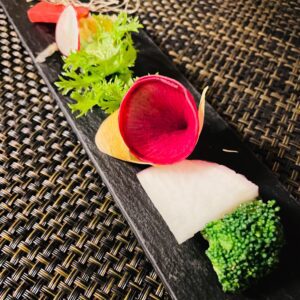
Next, I had “marinated Japanese amberjack”. It’s seasonal Japanese amberjack, but I felt that I didn’t really understand the deliciousness of the season when it was marinated.
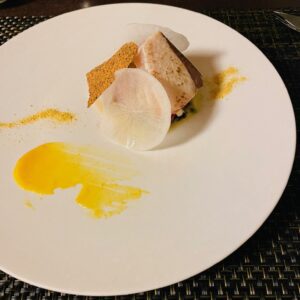
Next, I had “Turnip Velouté”. Velouté is a soup made from white vegetables such as turnips, white onions, and onions. It was a delicious soup.
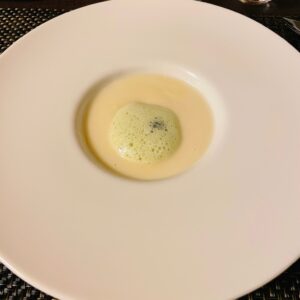
Next, I had “Grilled fresh fish (burdock accent, lees sauce)”. Especially, the fried burdock was delicious.
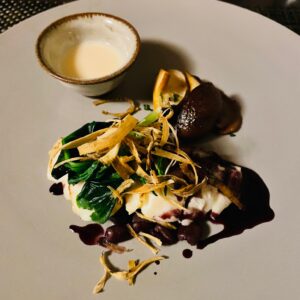
I had “Tajima beef roti” as the main dish. Roti is low-temperature roasted beef. It was very delicious, but it was a little streaky and hard to eat. By the way, Kobe beef is beef carefully selected from Tajima beef at the time of shipment. It is a pity that Tajima beef is less well known than Kobe beef. The Ministry of Agriculture, Forestry and Fisheries has selected “Kobe beef steak” as a “Local dishes loved by the nation” in Hyogo prefecture.
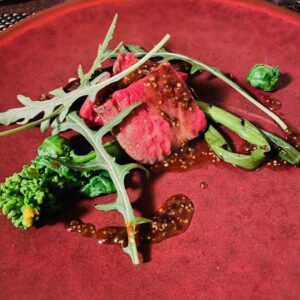
For dessert, I had “Strawberry and black soybean gratin”. Gratin is a French word for a technique of heating in an oven to add a brown color. This time there were many menu names I didn’t know about.
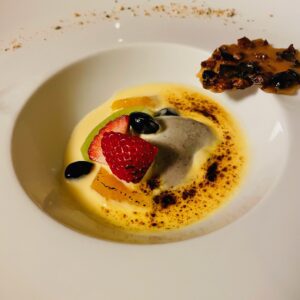
The overall impression of the supper was a beautiful presentation, but the taste was not impressive. It’s delicious overall, but it’s a shame that I couldn’t find a touching taste.
Note: The departure / arrival times, fares of transportation and admission fees, meal fees, etc. listed in the text are as of the time of writing the BLOG. Please check for yourself when you go on a trip as it may change in the future.